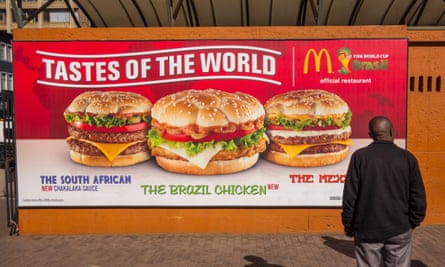Bonkinkosi Mofokeng was a skinny kid growing up. It was only when he got his first job that he started piling on the pounds. “I’d buy every junk food I could find and sit in front of the TV and eat,” says the 35-year-old, who lives in Mpumalanga in north-eastern South Africa. “The only weight I lifted was the food from the plate to my mouth.”
A little over a year ago, Mofokeng weighed more than 100kg (almost 16 stone) – a strain on his 170cm (5’5”) frame. The father of three worried he would have a heart attack or a stroke, conditions that run in his family. He decided to enter Bootcamp Mzanzi, a South African weight-loss reality TV show. In April last year, he was declared the winner, having dropped to 76kg and earning the moniker “the thin guy” from the show’s fans.
Mofokeng’s story is not unusual in South Africa, where obesity rates are on the rise, driven by increasingly sedentary lifestyles, a rise in disposable income and the popularity of cheap junk food. Sugary drinks, fat- and salt-laden crisps and fried chicken are becoming popular in South African diets. Traditional food such as pap (maize porridge) is still consumed, but increasingly with more protein.
Black women are the most affected. Almost a third are obese, putting them at an increased risk of a host of diseases, including type II diabetes, heart disease and stroke. There is also evidence from North America to suggest that children born to obese mothers run higher risks of becoming overweight and developing metabolic disorders.
But obesity has been somewhat overlooked as a health problem in the country, says Shane Norris, a health researcher at the University of the Witwatersrand in Johannesburg, and one of the brains behind the African Centre for Obesity Prevention (Action). The centre launched in November last year to strengthen obesity research in South Africa and is one of the first of its kind on the continent. “Our data shows that although obesity is a major health problem in South Africa, awareness of the problem is poor across the board,” he says.

The Action centre will collect data on obesity rates and gather the most effective prevention policies in tackling the epidemic. It will also link up with researchers across the continent, where obesity levels are rising too.
Africa’s obesity curves are typical of what happens when regions become wealthier, Norris says. “As countries develop, there is a trend. You get a drop in under-nutrition and then you have an increase in obesity, tied to a rise in diseases like type II diabetes,” he says. Alongside this, there’s a shift in mortality trends. The World Health Organisation estimates that non-communicable diseases, such as heart disease and cancer, will become the leading cause of death in Africa by 2030 (pdf).
Culture is one of the reasons why obesity has been overlooked, Norris explains. In many African cultures there is a notion that “bigger is better”. The country’s HIV epidemic reinforced these perceptions, as being thin became associated with Aids and disease, says Norris.
Mofokeng has a different explanation for the country’s obesity challenge. “During the apartheid era, blacks were denied access to most things,” he says. Unhealthy junk food, which is marketed as modern and sophisticated, has become popular in part because it is seen as a luxury that used to be unaffordable, he adds. “The fact that you can find these foods on every corner plays a role too.”
A special report on obesity published in the Lancet in 2011 reported that rapid urbanisation, as seen in South Africa post-apartheid, has led to people consuming more processed, energy-rich food. However, little work has been done on the links between urban planning and obesity in South Africa, says Norris.
Vicki Lambert, a sports science professor at the University of Cape Town, welcomes the Action centre as a good initiative. “There is a pressing need to better understand the drivers of obesity in South Africa, and more broadly in Africa,” she says.

Both Lambert and Norris say there is a particular need for interventions to target young people. According to Lambert, the number of obese and overweight South African adolescents increased by more than 20% between 2002 and 2008. And overweight children are likely to stay that way, says Norris. “We’ve found that if South African girls are overweight by the age of five, they are 40 times more likely to be obese as adults.”
An added complication in South Africa is its high levels of HIV infection. The country has the largest antiretroviral therapy programme in the world – nearly three million people were receiving therapy in 2014 – and researchers in the US have found increasing obesity among HIV-positive patients taking antiretroviral drugs.
In December last year, South Africa’s department of health published a five-year strategy for obesity prevention and control (pdf). One of its goals is to mobilise communities to help in the battle against the bulge. “We are pursuing community-based programmes for physical activity,” says Lambert. The challenges include unsafe or unattractive environments that inhibit physical activity. Investments in safe and efficient public transport, street lighting or traffic calming measures can have positive results, she says.
But for Mofokeng and his family, health starts at home. At first, he says, his wife and children were loath to give up their favourite junk food. Now they happily tuck into dinners of grilled chicken, avocado and mixed vegetables. He wants to bring what he’s learned to his community, but it has been difficult. His community training programme, which started with 90 people last year, has dwindled to 15 members due to a lack of facilities and training equipment, he says. He dreams of one day expanding his programme: “I really think I can save lives.”
Join our community of development professionals and humanitarians. Follow@GuardianGDP on Twitter.

Comments (…)
Sign in or create your Guardian account to join the discussion